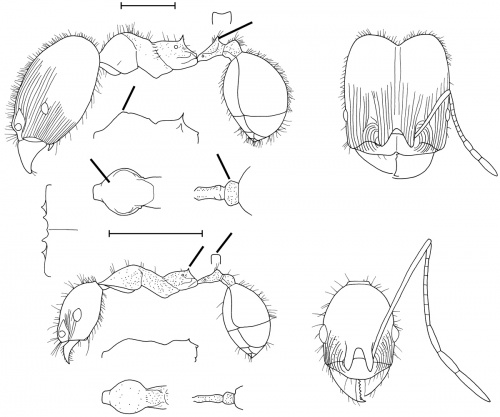Pheidole trageri
| Pheidole trageri | |
|---|---|
| Scientific classification | |
| Kingdom: | Animalia |
| Phylum: | Arthropoda |
| Class: | Insecta |
| Order: | Hymenoptera |
| Family: | Formicidae |
| Subfamily: | Myrmicinae |
| Tribe: | Attini |
| Genus: | Pheidole |
| Species: | P. trageri |
| Binomial name | |
| Pheidole trageri Wilson, 2003 | |
Nothing is known about the biology of trageri.
Identification
See the description in the nomenclature section.
Keys including this Species
Distribution
Only known from the type locality.
Latitudinal Distribution Pattern
Latitudinal Range: -9.7° to -9.7°.
| North Temperate |
North Subtropical |
Tropical | South Subtropical |
South Temperate |
- Source: AntMaps
Distribution based on Regional Taxon Lists
Neotropical Region: Brazil (type locality).
Distribution based on AntMaps
Distribution based on AntWeb specimens
Check data from AntWeb
Countries Occupied
| Number of countries occupied by this species based on AntWiki Regional Taxon Lists. In general, fewer countries occupied indicates a narrower range, while more countries indicates a more widespread species. |

|
Estimated Abundance
| Relative abundance based on number of AntMaps records per species (this species within the purple bar). Fewer records (to the left) indicates a less abundant/encountered species while more records (to the right) indicates more abundant/encountered species. |

|
Biology
Castes
Nomenclature
The following information is derived from Barry Bolton's Online Catalogue of the Ants of the World.
- trageri. Pheidole trageri Wilson, 2003: 358, figs. (s.w.) BRAZIL.
Unless otherwise noted the text for the remainder of this section is reported from the publication that includes the original description.
Description
A member of a complex of Pheidole species with giant majors having short bristly hair, in the fallax group and comprising Pheidole astur, Pheidole oxyops, Pheidole praeusta and Pheidole trageri. P. trageri is distinguished among them by the following combination of traits.
Major: lacking rugoreticulum on head; one carinula on each side of the dorsal cephalic midline reaches the occiput but otherwise nearly the entire posterior half of the dorsal surface of the head capsule is smooth and shiny; pronotum faintly bilobous in dorsaloblique view; propodeal spines stout, long, and vertical to the basal propodeal face; postpetiolar node seen from above trapezoidal; pronotum entirely smooth and shiny.
Minor: occiput narrowed somewhat, with nuchal collar; propodeal spine reduced to a denticle; entire mesosoma, including pronotum, foveolate and opaque.
MEASUREMENTS (mm) Holotype major: HW 2.10, HL 2.44, SL 1.04, EL 0.26, PW 0.92. Paratype minor: HW 0.62, HL 0.80, SL 0.94, EL 0.16, PW 0.44.
COLOR Major: light reddish yellow (light “orange”), color deepening from middle of head forward, reaching light reddish brown on mandibles.
Minor: concolorous yellow.
Figure. Upper: holotype, major. Lower: paratype, minor. Scale bars = 1 mm.
Type Material
BRAZIL: campus of Universidade Federale de Mato Grosso, Cuiabá, Mato Grosso, col. James Trager. Museum of Comparative Zoology
Etymology
Named after the myrmecologist and collector of the type series James Trager.
References
- Wilson, E. O. 2003. Pheidole in the New World: A dominant, hyperdiverse ant genus. Harvard University Press, Cambridge, MA. (page 358, fig. major, minor described)
References based on Global Ant Biodiversity Informatics
- Wilson E. O. 2003. Pheidole in the New World. A dominant, hyperdiverse ant genus. Cambridge, Mass.: Harvard University Press, [ix] + 794 pp.
